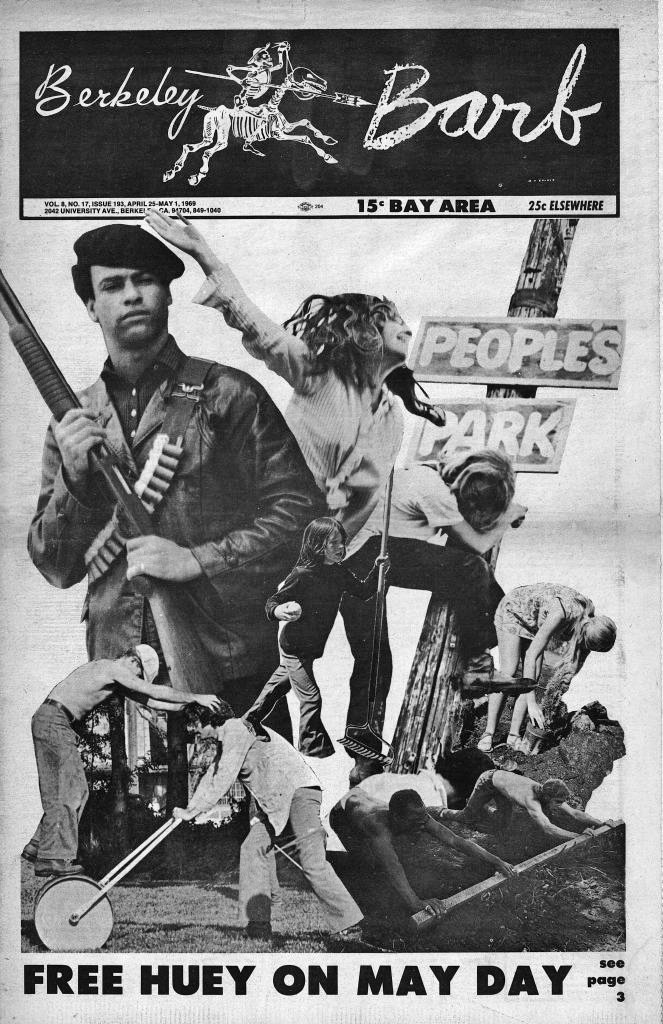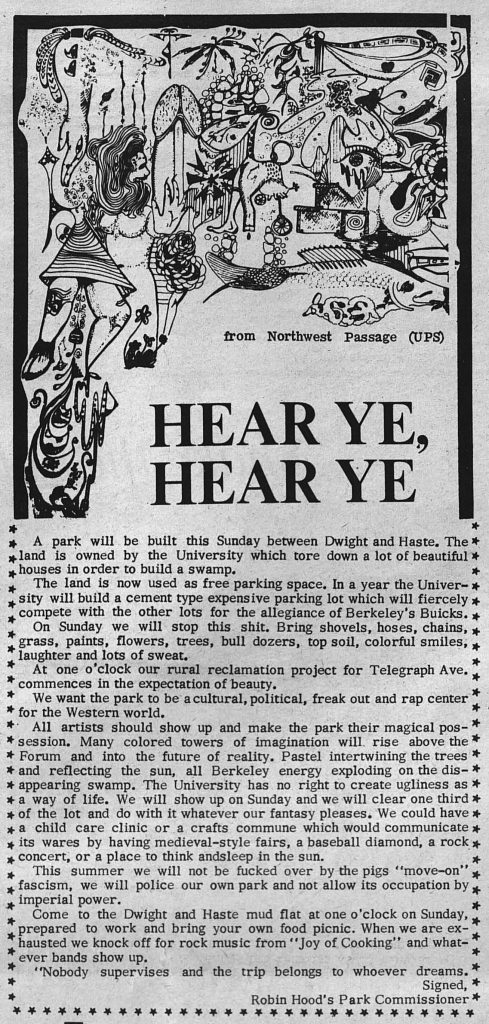
Berkeley’s vibrant counterculture included anti-war and free speech activists, the Black Power Movement and Cal students from across the country. The square block along Telegraph, Bowditch, Haste and Dwight Way—soon to become People’s Park—was a nucleus of countercultural activity. A thriving community of small businesses, musicians, writers, residents of the large shingled homes on the block, and student-created organizations existed there.In comes the UC Regents, who applied eminent domain to raze the block, supposedly to build a sports complex. Residents were evicted. Homeowners were paid less than half the market value for their homes. Once vacated, bulldozers leveled the area. Soon thereafter, UC abandoned its plan and the site degenerated into a trash heap.
Community members petitioned the city to allow for a park. The city, aligned with the university’s interests, took no action.
In April of 1969, the independent newspaper, the Berkeley Barb, printed a call to build the park by hand.
“On Sunday we will stop this shit. Bring shovels, hoses, chains, grass, paints, flowers, trees, bulldozers, topsoil, colorful smiles, laughter and lots of sweat. At one o’clock our rural reclamation project for Telegraph Ave. commences in the expectation of beauty. We want the park to be a cultural, political, freak out and rap center for the Western world,” the bulletin in the Barb said.
Funds were raised and crowds of old and young, professors, hippies, revolutionaries and students of many races and religions joined in a common vision and collective design. People’s Park was born!
From its inception, the park was an affront to the state and to capitalist ideology. Governor Reagan vowed to destroy the movement in Berkeley. UC Berkeley Chancellor Roger Heyns gave the order to clear the property on May 15, 1969. Berkeley police and the California Highway Patrol escorted bulldozers that blocked the park. A chain link fence was erected.

In response, students organized with the rallying cry “take back the park.” Thousands gathered in the streets and rooftops around People’s Park. The police used tear gas and rubber bullets to disperse crowds. State troopers and sheriff deputies employed live ammunition.
James Rector was killed when bullets pierced his aorta. Hundreds were wounded. Reagan mandated a military camp at the Marina, while peaceful protesters spilled off campus into the streets. The battle lasted 16 days. On May 30, 1969, Reagan retreated, withdrawing the National Guard.
The stage for the current crisis was set in July, 2021, when the City Council let themselves be bought for only $83M to approve UC’s community-crushing Long Range Development plan. Their plan includes building on People’s Park, a violation of Measure L passed in 1986 to ensure 2-acres of recreational area for every 1,000 Berkeley residents. The Regents are determined to erase People’s Park, an iconic symbol of resistance to state power and state violence.
Today, the university continues to threaten this historic site and its residents. The time to act is now! Let’s demand accountability for those who have lost their homes. Let’s end the deadly conflict and demand that People’s Park be saved. The coming weeks will be pivotal.
It is key to show up, be present in the park, and videotape the police action in the park. Here’s why: Monitoring police activity may provide a deterrent against police misconduct. If police brutality occurs, we have evidence that may be used in a future lawsuit. We can use the footage to educate the public and build a case for abolition.
Text ‘SAVETHEPARK’ to 74121 to receive bulldozer alerts
There is a diversity of tactics of action. Participate in whatever way you are able. Here are some Copwatching strategy tips: Preserve video evidence, focus videos on the police, and remember your right to watch! Be aware of what you say while recording and give location, date, and time of video. Keep your camera on you and stay vigilant, maintaining situational awareness.
To build on People’s Park, UC must first empty it of the people. UC is doing that right now. The university evicted and relocated half of the residents at People’s Park to the Rodeway Inn. What about the rest of the people at the park?
We face an impending crisis.
Once UC has filled the Rodeway, or when there are no other people who want to move in—the UCPD will ambush the park at any time to evict the rest of those living at People’s Park. As in past attempts to seize the Park, we expect a fence to be erected and guarded by police, to enable the new construction.
We, the people, must save the park! Calling anyone and everyone: NOW is our moment to act!
Text “SAVETHEPARK” to 74121 to receive bulldozer alerts. But don’t wait. Creative, nonviolent actions are being planned, plan yours! Spread the resistance.
Get active. Be aware. Refuse to be abused.
Berkeley Copwatch is an all-volunteer organization with the goal to reduce police violence through direct observation and holding police accountable for their actions. Formed in 1990, they seek to educate the public about their rights, police conduct in the Berkeley community and issues related to the role of police in our society at large. For more information visit www.berkeleycopwatch.org.
